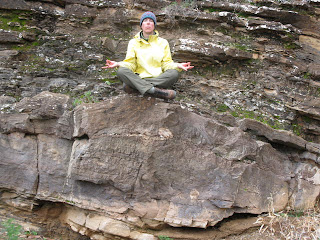Students often want to know how "we" - the scientific community - know how old a particular rock formation is. Its not like anyone was around during the Earth's early formation to document its "first steps". There is no Wikipedia page outlining the year each layer was formed Rather, we have to collect clues from the rocks themselves in order to constrain the age of the various bedding layers that we are studying. There are two ways to consider how old a rock formation is: relative dating and absolute dating. Relative dating is not asking your cousin out for coffee; rather, it is when we compare the age of one layer to the next. Most of the time, the oldest layers will be on the bottom and younger layers will be on top. It is the equivalent of saying: I am younger than my mother, but older than my sister. Absolute dating is giving an actual number age to a particular rock. I am 33 y.o. (years old), my mom is 62 y.o., and my sister is 29 y.o. We know the ages of my family because of birth certificates and the fact that people have been around long enough to document each year of our lives.
The best way to give an absolute age for a rock formation is to locate an igneous rock. Molten rock that is ejected from a volcano will create igneous rocks. The ash debris spit out from a volcano can cool and create an igneous (or ash) layer as well. The benefit of the ash layers are that they can travel great distances by currents in our atmosphere far away from the original volcano. Within the ash layers, there are small grains called zircons. Zircon isotopes will decay at a certain rate (half life). If we know the rate of decay, analysis of the amount of decay that has occurred will determine an age of the zircon; and therefore, the age of the ash layer it is found within. As I mentioned in the previous entry, there is only one layer that has been positively dated in this area of Australia placing the rocks at approximately 635 mya. Ideally, more ash layers will be located. The more positively dated layers, the more accurately we can pinpoint the ages of the various formations. For instance, if there are multiple ash layers with one located at the bottom and one at the top of the Trezona formation, we would be able to determine when and for how long this paleo-environment lasted. Such a scenario of formations bookended with identified ashes is somewhat of a fairy tale in geology world. Regardless, we are intrepid and ready to begin a search for the desireable ashes.
Such was our quest! Last field season four potential ash layers were located and sampled by the Princeton team. Two of those previously sampled provided good dates, and two seemed less reliable. Our goal this season is to relocate these ashes, collect more samples for analysis, follow them laterally, and hunt for additional layers in other locations. We have GPS locations for the four previous ash layers and a written description for an additional one. Not too bad, sounds doable. Bring on the ash.
Ash hunting days are not always the most, shall we say, rewarding days. I have been informed that ashes tend to be recessed layers. Although, depending on the deposition of the ash, it can create a solid resistant layer. The rock tends to be green (but one of the previous sampled ashes was red) that may or may not be sparkly. Can we say needle in a hay stack! Yesterday, Catherine and I worked our way through three separate locations of possible ash sightings. The outcrops consisted of 20 plus feet of alternating red and green siltstone. These siltstones maintain various levels of weathering resistance. Some are crumbling debris layers. Others are resistant ridges. In the sun, many of them sparkle with secondary micas and other glittery minerals. Standing on the side of one such cliff, armed with my rock hammer and hand-lens, I began to understand why there has only been one positively dated ash layer in the area - they are elusive and difficult to distinguish (at least for me). In the end, we confidently resampled one of the three previously sampled ashes and the jury is still out on our success in locating the additional ashes. Catherine has informed me that we can never do more than one ash hunting day in a row as it is soul destroying, and I am considering the possible use of mood enhancers. Stay posted on our future successes in Operation Ash Location!
 |
| Three possible ash layers. The oldest layer is about a meter below where Catherine is standing. The second potential ash is the layer she is standing on and the youngest is where she is pointing. |

























